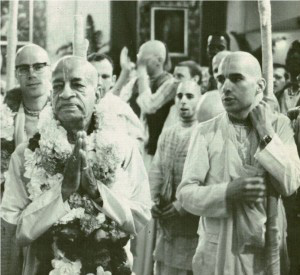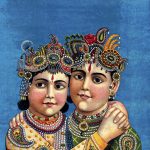The West’s encounter with gurus representing various Eastern traditions has left it with mixed feelings. Theoretically the experience should be overwhelmingly positive. Thus broadly speaking any negative experience should be a result of either misrepresentation or misunderstanding. Negative experience derives that is from the fact that misrepresentation in the name of sri guru has occurred. Additionally, misunderstanding on the part of the student of what is to be expected from the guru as well as what is to be expected from the disciple have also played a role.
The Bhagavata offers salient advice to help one navigate the waters of selecting its notion of sri guru, such that one can more readily avoid misrepresentation. What are the essential qualities of the guru? What should one expect from the spiritual guide? The Bhagavata answers these questions. It also informs us of what is expected of one seeking the guru’s guidance—what are the qualities of a disciple. The Bhagavata does this concisely in one key verse, one that is most cited by the Gaudiya acaryas as an explanation of the qualities of both the guru and disciple.
tasmad gurum prapadyeta, jijnasuh sreya uttamam
sabde pare ca nisnatam, brahmany upasamasrayam“Therefore one who is interested in a comprehensive solution to struggle for existence and the pursuit of wise love should surrender to a guru who is expert in explaining the theistic essence of the sacred texts—their implications and ramifications in consideration of time, place and circumstances—and who is also fixed in God realization, symptomized by the ability to quell the tide of human passion.” Srimad Bhagavatam, 11.3.21
First we learn that sri guru is not for everyone. This manifestation of divinity is intended for those interested in making a comprehensive solution to life’s problems, not a “band-aid” solution that merely treats symptoms. Such a so-called solution often solves one problem only to create another, however sri guru manifests to offer a comprehensive solution and this is a solution not to the world’s problems, but rather to the perception of a world of problems.
Shall we free the fly caught in the spider’s web only to force the spider to go hungry? Will food supplied to the stomach ever end hunger more than for the moment? What is the meaning of kindness in a world in which one living being is food for another? In this world one person’s feast is another’s funeral. And all of this, the guru teaches, is a product of misunderstanding—maya. It is all a mistake, an error in perception. Indeed our problems when properly understood are themselves part of the solution. Sri guru manifests to help us correct this error of perception, to change our angle of vision and thus treat the disease rather than merely its symptoms.
The disciple is one who is prepared to die an ego death in order to live in divine love. Such a desperate person is preoccupied (jijnasuh) with the supreme good (sreyah uttamam) that includes within it ending the material struggle for existence. That good itself is wise love—prema bhakti—reposed exclusively in the divine root of all existence. Only wise love has the power to turn faults into ornaments and problems into solutions. With this in mind, one should approach sri guru (gurum prapadyeta) and give up any piecemeal effort to solve the puzzle of Visnu-maya.
What are the qualifications of sri guru? Sabde pare ca nistanam. Here the Bhagavata speaks very practically. It speaks in terms of observable characteristics. Sri guru has heard with his or her heart (sabde) and is thus well versed in theoretical knowledge (nisnatam) of the Godhead (pare) that seeks to articulate the ineffable. Sri guru has not learned the text by committing it to memory, but rather the spiritual preceptor has entered into the text and thus understands how to extend its capacity to shed light. The guru’s feeling and taste for the text gives rise to reason as to its implications. In other words, sri guru speaks the language of love required to live in the text as well as that of reason. Thus he or she is capable of extending the argument of revelation—its relevance—such that its universal application for all times and circumstances is brought to light.
The sacred texts map the inner landscape on the course to prema and sri guru guides the course. This connection between map and guide is significant. The map stands as a standard of revealed knowledge that sri guru is fully acquainted with. Sri guru is therefore not one to make it up along the way. The spiritual preceptor represents a tradition rooted in revelation and a particular perspective on the revealed texts and thereby the Godhead. This is a perspective that has been practiced, passed down, and leaves in its passing many examples of those who successfully traversed the course to its perfection.
Furthermore sri guru is upasama-asrayam, free from lust, anger, greed, etc. The spiritual guide is sheltered (asrayam) in equipoise (upasama) with regard to human passions. This is only possible if one has taken one’s stand on the ground of being (brahmani). Sri guru is thus also free from material bias and thereby uncompromised. These are significant accomplishments, even as they speak to us of the entry level of spiritual attainment. Decorated with these qualities, sri guru stands like the towering lighthouse in the night for those lost at sea, dissipating the shadows of their fear and illuminating their hearts with the hope that the shore is near.
The above explanation of the words “upasama-asrayam” are repeated throughout the Gaudiya commentaries. Along with sri guru’s attribute of being well versed in theoretical knowledge, the more internal qualities which speak more directly of inner realization are nonetheless observable as well. What would be the value of speaking of qualities that are not so? How would that help one to navigate the waters in pursuit of a guide?
To be sure, there are other essential but less readily observable attainments that sri guru should possess, particularly within the Gaudiya tradition. But short of the observable qualities mentioned above, these more esoteric realizations will not manifest. Material dispassion arrived at through spiritual practice is followed by spiritual emotion. The latter does not manifest before the former. Should the former observable qualities manifest in the context of a life of bhakti, we have good reason to believe that the more significant attainment of spiritual emotion lies beneath the surface of our prospective spiritual preceptor.
While the Bhagavata’s advice is very practical, arguably it is also open to interpretation as to what constitutes a command of theoretical knowledge and equipoise on the part of the guide. However, the inner necessity of the disciple described in this verse is not ambiguous. Along with this, it is a combination of our sincerity and also our previous bhakti samskaras or impressions from prior encounters with bhakti that determine our ability to connect with the principle and person of sri guru. Should our choice prove less than ideal, we are then better equipped to choose again and come, as we must, under the affectionate care of a genuine guardian angel of Gaudiya Vedanta.
In concluding this short essay in celebration of the tirobhava mahotsava of my beloved guide, Srila A.C Bhaktivedanta Swami Prabhupada, allow me to cite the following poetic insight of Swami B.R. Sridhara Deva Goswami on the unavoidable role of the guru in our lives.
To err is human. To err is inevitable for all, being not perfect. Still, no one wants to remain imperfect. There is an element within all that is animate that tends towards perfection. If it were not so, we would feel no want at all. Our tendency towards perfection is certainly very weak and limited; otherwise we could attain the goal at once. Our limited capacity and tendency for perfection makes room for the guide or guru.
The imperfect is not so if it is not in need of help, and that also from beyond itself. The perfect is not perfect if it cannot assert itself or help others, and that too, of its own accord. So the guidance to perfection or Absolute Truth is necessarily a function of the Absolute itself, and the divine agent through whom this function manifests is sri guru or the divine guide.











